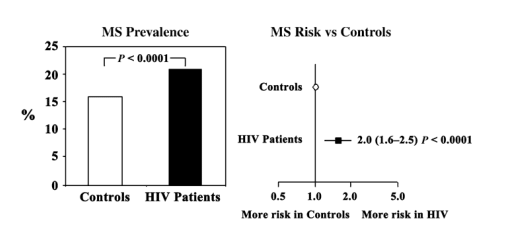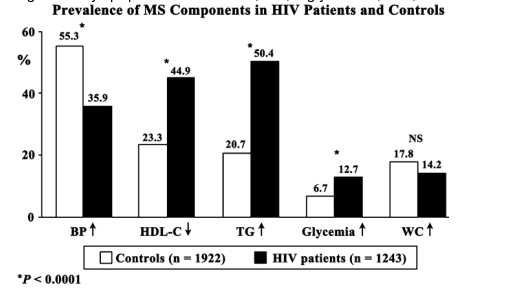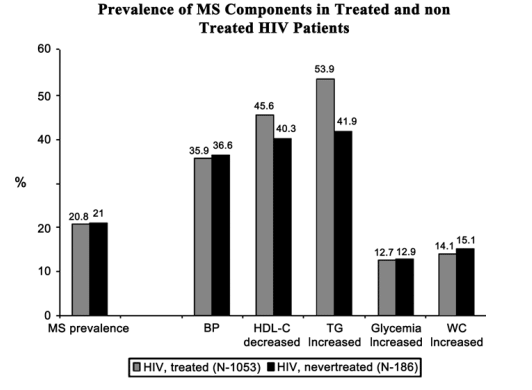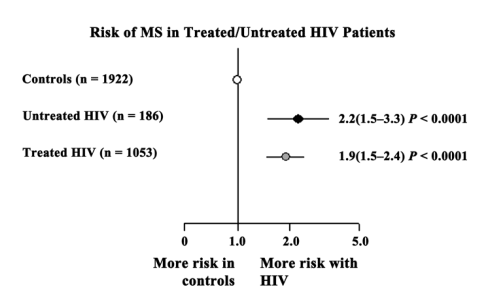| |
HIV and Metabolic Syndrome: A Comparison With the General Population in Italy. Metabolic Syndrome Higher in HIV+ ART Untreated & Treated Compared to HIV-negatives
|
| |
| |
JAIDS Journal of Acquired Immune Deficiency Syndromes:Volume 45(4)1 August 2007pp 426-431
Bonfanti, Paolo MD*; Giannattasio, Cristina MD; Ricci, Elena ScD*; Facchetti, Rita ScD; Rosella, Elena MD; Franzetti, Marzia MD; Cordier, Laura MD*; Pusterla, Luigi MD; Bombelli, Michele MD; Sega, Roberto MD; Quirino, Tiziana MD; Mancia, Giuseppe MD
From the *Department of Infectious Diseases, Luigi Sacco Hospital, Milan, Italy; Clinica Medica, Department of Internal Medicine, Prevention and Applied Biotechnologies, University of Milan-Bicocca, and S. Gerardo Hospital, Monza, Milan, Italy; Malattie a Trasmissione Sessuale Azienda Sanitaria Locale III, Milan, Italy; Divisione di Malattie Infettive, Padova Hospital, Padova, Italy; Divisione di Malattie Infettive, Sant'Anna Hospital, Como, Italy; and the Divisione di Malattie Infettive, Busto Arsizio Hospital, Busto Arsizio, Italy.
"....(1) Metabolic Syndrome (MS) was similarly increased in HIV-infected patients treated with antiretroviral drugs and in those never exposed to this therapeutic strategy and (2) the higher prevalence of the lipid and glucose components of MS in HIV-infected patients compared with controls was similar in the treated and never-treated groups... the prevalence of MS in the HIV-positive group was 20.8%, whereas it was only 15.8% in the control group, with the difference being statistically significant, and the risk of having MS was twice as large when adjustment was made for between-group discrepancies, including gender and age.... the MS prevalence and the prevalence of MS components were similar in the 2 groups (21%), with a slightly and nonsignificant greater preponderance of the lipid abnormalities in the treated group......Treated and untreated HIV-positive patients also showed a similar increase(2-fold) in the age- and gender-adjusted risk of having MS compared with controls....another report by Mondy et al found no difference in the risk of MS using matched controls selected by the same cohort (National Health and Nutrition Examination Survey [NHANES]). We expected a higher prevalence in the HIV-positive population in these US studies if our results were correct. This difference could be attributable to a different pattern of criteria leading to the MS diagnosis; specifically, increased waist circumference, which is the leading criterion in the US population (38.6%),39 was present only in 17.8% of the PAMELA study sample..."
Abstract
Objective: To compare the prevalence of metabolic syndrome (MS) in HIV-positive patients with that from a sample of a general Italian population.
Design: Cross-sectional study.
Methods: A total of 1263 HIV-infected patients 18 years of age or older were recruited in 18 centers for infectious diseases in northern and central Italy. Controls were 2051 subjects aged 25 to 74 years representative of the residents of Monza, a town in Milan province, who were enrolled in the Pressioni Arteriose Monitorate E Loro Associazioni study.
Results: The prevalence of MS in the HIV group was 20.8%, whereas in the control group, it was only 15.8%, with the difference being statistically significant. The age- and gender-adjusted risk of having MS in HIV-infected patients was twice as great as that in controls. Compared with controls, HIV-infected patients had a greater prevalence of the impaired fasting glucose, increased plasma triglycerides, and reduced high-density lipoprotein cholesterol components. MS prevalence was similar in treated and never-treated HIV-infected patients, and so were the various MS components.
Conclusions: The risk of MS is greater in HIV-infected patients compared with the general population because of a greater prevalence of lipid and glucose abnormalities. The prevalence of MS and its components is similar in treated and untreated HIV-positive patients.
Several studies have reported that the metabolic syndrome (MS), a condition characterized by the clustering of alterations in glucose metabolism, lipid metabolism, and blood pressure,1-14 is more common in subjects with HIV infection than in HIV-negative individuals.15-17 This has been ascribed to the use of antiretroviral therapy,18-20 which is associated with functional and morphologic alterations (eg, dyslipidemia, diabetes, increase in visceral fat, lipodystrophy) that fit several criteria by which MS is diagnosed.1-14 A higher prevalence of MS in HIV-infected patients has not been found in all studies,21,22 however, and the true quantitative impact of HIV infection for a condition that has a high prevalence in the general population5,8,10 is not clear. Furthermore, because few observations are available on the prevalence of MS traits in untreated HIV-positive individuals,17,23-26 it is also not clear whether antiretroviral treatment rather than the HIV infection per se has an important mechanistic role.
The aim of the present study was to compare the prevalence of MS in HIV-infected patients recruited in the context of a large cross-sectional Italian survey27 with that in a sample of a general Italian population.28 It was also to determine whether MS and its components have a different frequency in treated and untreated HIV-infected patients. It was thought that providing a large-scale database on MS in HIV-positive patients might be of major clinical interest, because the increasing survival of these patients makes them more prone to the adverse prognostic effect of MS.29-32
METHODS
A total of 1263 HIV-infected patients were made available by the Sindrome Metabolica One (SiMOne) study, which included 18 centers for infectious diseases in northern and central Italy.27 All patients seen between February and April 2005 were considered. Exclusion criteria were (1) age <18 years, (2) hepatic cirrhosis, (3) nonwhite ethnicity, and (4) pregnancy. In each patient, data collection included demographic variables; history of cardiovascular disease, diabetes, or hypertension; use of antidiabetic, antihypertensive, or lipid-lowering drugs; and previous or current treatment with antiretroviral drugs. Blood pressure was measured with the patient in the sitting position, using a mercury sphygmomanometer and taking the first and fifth Korotkov sounds to indicate systolic and diastolic values, respectively. Waist circumference was measured with the patient standing. Plasma triglycerides, high-density lipoprotein (HDL) cholesterol, total serum cholesterol, and fasting plasma glucose were measured from a venous blood sample by a radioenzymatic method. MS was diagnosed according to the 2003 Adult Treatment Panel (ATP) III criteria (ie, when at least 3 of the following alterations were present: (1) waist circumference >102 cm in men and >88 cm in women, (2) HDL cholesterol level <40 mg/dL in men and <50 mg/dL in women, (3) plasma triglyceride value ≥150 mg/dL, (4) fasting plasma glucose value ≥110 mg/dL or use of antidiabetic drugs, and (5) blood pressure value ≥130 mm Hg systolic or ≥85 mm Hg diastolic). Regardless of the blood pressure or blood glucose values, use of antihypertensive or antidiabetic drugs was taken to indicate the presence of a blood pressure or blood glucose alteration, respectively. Except for information on antiretroviral treatment, similar procedures (ie, fasting condition at the time of blood work, same blood pressure and waist circumference measurement methods) were adopted in the control population. This consisted of subjects from the Pressioni Arteriose Monitorate E Loro Associazioni (PAMELA) study (ie, an observational study on 2051 subjects aged 25 to 74 years who were representative of the residents of Monza, a town close to Milan, in the Lombardy region).28 Patients in PAMELA study were formally sampled from the general population and enrolled in 1995. They were followed up in subsequent years. The choice of analyzing the baseline data was made on the basis that a recent Italian study33 found a similar prevalence; moreover, although data from the PAMELA study follow-up were temporally closer, they were from older subjects.
The prevalence of MS in HIV-infected patients and controls was compared by the _2 test, according to the Cochran-Mantel-Haenszel method.34-36 Odds ratios (ORs) and the corresponding 95% confidence limits were used as estimators of the relative risk of having MS in HIV-positive patients, taking controls as a reference and using unconditional multiple logistic regressions fitted by the method of maximum likelihood. Variables such as age and gender were included in the regressions. A P value <0.05 was taken as the level of statistical significance. All analyses were done by means of SAS/STAT, version 8.2, software (SAS Institute Inc., Cary, NC).
RESULTS
Twenty HIV-infected patients (1.6%) from the SiMOne study and 129 (6.3%) patients from the PAMELA study were excluded from the data analysis because of lack of information on at least 1 criterion for the diagnosis of MS. Because data on HIV-positive subjects were collected in 18 centers, we tested for difference in MS and single criterion prevalence by geographic areas (Lombardy, northern Italy, and central Italy). No statistically significant difference emerged (data not shown).
Table 1 shows the demographic and clinical characteristics of the 2 study populations. Compared with the PAMELA controls (n = 1922), the 1243 HIV-infected patients were younger and had a much higher male prevalence, much lower body mass index, and higher rate of smoking. As shown in Figure 1, the prevalence of MS in the HIV-positive group was 20.8%, whereas it was only 15.8% in the control group, with the difference being statistically significant, and the risk of having MS was twice as large when adjustment was made for between-group discrepancies, including gender and age (see Table 1).
Figure 2 shows the prevalence of MS components in HIV-infected patients and controls with MS. Compared with controls, HIV-infected patients had a markedly greater prevalence of the impaired fasting glucose, increased plasma triglycerides, and reduced HDL cholesterol components. In contrast, the raised blood pressure component was less in HIV-infected patients than in controls with MS, and the increased waist circumference component was not significantly different in the 2 groups.
FIGURE 1. Left panel shows the prevalence of MS in HIV-infected patients and controls. The right panel shows the OR for MS in HIV-positive patients compared with controls after adjustment for between-group differences, including age and gender.

FIGURE 2. Prevalence of MS components in HIV-infected patients and controls, both with MS. The asterisk refers to the statistical significance (P < 0.0001) of the differences between groups. BP indicates blood pressure; HDL-C, high-density lipoprotein cholesterol; TG, triglycerides; WC, waist circumference.

Figure 3 shows the data obtained in the HIV-positive patients (15% of the total HIV population) who had never taken antiretroviral drugs in comparison to those under treatment. Mean age was slightly but significantly different between the 2 groups (43.4 ± 9.1 years and 41.8 ± 9.4 years [Pt test = 0.02] for treated and naive patients, respectively). Nevertheless, the MS prevalence and the prevalence of MS components were similar in the 2 groups (21%), with a slightly and nonsignificant greater preponderance of the lipid abnormalities in the treated group. As previously reported,27 a more detailed analysis on the effect of drug treatment showed a significant difference in patients with past protease inhibitor (PI) treatment; no current drug class treatment seemed to have an effect on the diagnosis of MS, although patients currently treated with nonnucleoside reverse transcriptase inhibitors (NNRTI) had a mean HDL cholesterol value significantly higher than that of subjects not treated with NNRTIs (52 vs. 46). Treated and untreated HIV-positive patients also showed a similar increase(2-fold) in the age- and gender-adjusted risk of having MS compared with controls (Fig. 4). Smoking habit was introduced in the multivariate logistic regression model and then removed because it was not significantly related to MS.
FIGURE 3. Prevalence of MS and its components in never-treated and treated HIV-infected patients. Explanations and symbols are as in preceding figures. BP indicates blood pressure; HDL-C, high-density lipoprotein cholesterol; TG, triglycerides; WC, waist circumference.

FIGURE 4. OR for MS in never-treated and treated HIV-infected patients compared with controls. Data are adjusted for between-group differences in age and gender.

DISCUSSION
The present study shows that alterations of lipid and glucose metabolism were more common in HIV-infected subjects than in individuals from the PAMELA study, which resulted in the prevalence of MS in the HIV condition to be greater than that of the control population.
It also shows that this was the case even if control individuals had an older average age than HIV-infected patients, and thus a greater chance of having a condition whose components and overall prevalence are closely related to age.10 The MS prevalence in the PAMELA study is consistent with other findings from Italy33,38 but lower than in United States39 and other countries.40
It finally shows that when adjustment was made for age and other between-group differences, the risk of HIV-positive patients having MS was more than twice that of control individuals; indeed, the prevalence of MS in the HIV population was 29.1% after standardization for gender and age.
These data confirm previous observations that MS is more frequent in HIV-infected patients,15-17 but our findings are inconsistent with respect to 2 recently published articles. Jacobson et al41 found that the risk of having lower HDL or higher triglycerides increased in HIV-infected patients but that the overall risk of MS was lower in these patients than in the general population because of the lower risks in the other components of MS. In this study, a selection bias toward healthier subjects could exist, because HIV-infected patients were recruited if they volunteered for surveillance on the relation between HIV infection and nutrition. Nevertheless, another report by Mondy et al42 found no difference in the risk of MS using matched controls selected by the same cohort (National Health and Nutrition Examination Survey [NHANES]). We expected a higher prevalence in the HIV-positive population in these US studies if our results were correct. This difference could be attributable to a different pattern of criteria leading to the MS diagnosis; specifically, increased waist circumference, which is the leading criterion in the US population (38.6%),39 was present only in 17.8% of the PAMELA study sample. In a population with a higher prevalence of obesity, such as in the United States, the effects of highly active antiretroviral therapy (HAART)-related lipodystrophy could be more evident on subcutaneous fat, leading to the significant difference between HIV-positive subjects and controls found by Mondy et al42 but not in our study.
Major strengths of our study are that it was based on the largest number of HIV cases, to our knowledge, ever examined for this purpose and that it included all the patients routinely referring to HIV Italian centers in the considered period. Although the sample was not formally representative of the Italian HIV-infected population, no selection was made on the basis of gender, age, mode of transmission, infection stage, antiretroviral treatment, lifestyle habits, or concomitant diseases. In this study, we found that the risk of HIV-infected patients having MS is not marginally but substantially greater.
In previous studies on the increased prevalence of MS in HIV-positive patients, the hypothesis was advanced that this originates from the effects of the antiretroviral therapy that is used for the treatment of AIDS,29-32 because these drugs can adversely affect glucose and lipid metabolism, as clinically documented by the increased prevalence of lipodystrophy associated with their use.24-26,30,43 The results of the present study do not confirm this interpretation of available data, however, because they show that (1) MS was similarly increased in HIV-infected patients treated with antiretroviral drugs and in those never exposed to this therapeutic strategy and (2) the higher prevalence of the lipid and glucose components of MS in HIV-infected patients compared with controls was similar in the treated and never-treated groups. This provides support to earlier suggestions24-26 that although antiretroviral treatment can cause adverse modifications of lipid and glucose metabolism, these modifications can be induced by the HIV infection per se. Our data indeed suggest that this may play a major role. The mechanisms involved in this phenomenon remain to be clarified.
A few additional issues deserve to be discussed. First, the prevalence of plasma triglycerides, HDL cholesterol, and glucose abnormalities increases with age.10 Yet, these abnormalities were much more common in younger HIV-infected patients than in older controls, indicating how powerful the dysmetabolic influence of HIV per se and/or HIV-related treatment can be. Second, blood pressure abnormalities were a much less common component of MS in HIV-infected patients than in controls. This can be accounted for, however, by the younger age of HIV-infected patients in our study as compared to controls, because systolic blood pressure increases steeply with age.28 This implies that by adding the blood pressure components, MS may be an even more common condition in an aged HIV-positive population than that observed in the present study.
Finally, our study has some limitations. Some differences exist between SiMOne and PAMELA recruitment criteria. Subjects with hepatic cirrhosis, pregnant women, and nonwhite patients were excluded from the SiMOne study but not from the PAMELA study. The percentage of subjects with these characteristics was so low, however, that it can be considered negligible. The presence of other confounders, such as injection drug use (IDU) and hepatitis C virus (HCV) infection, was not collected. Although a recent Italian study44 estimated that the prevalence of HCV infection in Italy was 4.4%, 40% of HIV-positive patients referring to the Coordinamento Italiano Studio Allergie Infezione da HIV (CISAI) Group centers were coinfected with HCV;45 thus, it can be assumed that HCV prevalence in the SiMOne group was much higher than in the PAMELA group. Nevertheless, the evidence regarding the relation between HCV and diagnostic criteria for MS is controversial. In some studies, a positive relation emerged between HCV infection and hypercholesterolemia in HIV-negative46 and HIV-positive47 subjects, but no association was found with triglycerides and HDL cholesterol. Jan et al48 found that HCV infection was positively related to HDL cholesterol abnormalities but inversely related to hypertriglyceridemia. Conversely, other studies found that insulin resistance was associated with HCV infection.49,50 Whether HCV infection contributes to increase or diminish the prevalence of MS remains a question; thus, it is difficult to establish the direction of bias because of the lack of this information.
Another limitation is the incomplete geographic and temporal overlapping of the HIV-infected and control populations and the cross-sectional nature of this study, which does not allow to us determine whether and to what extent having MS alters the prognosis of HIV-infected patients. There is evidence that MS markedly increases the risk of cardiovascular morbidity and mortality,3-6 however, which allows us to suggest that the outcome of HIV patients may also be adversely affected. This is of clinical relevance, because current treatment has markedly prolonged survival in this condition, making the chance of having a cardiovascular event real.
|
|
| |
| |
|
|
|